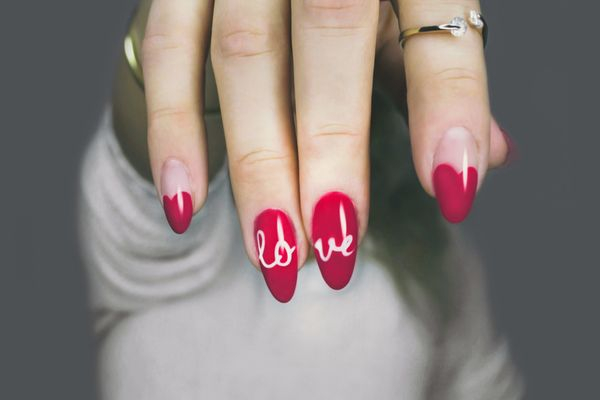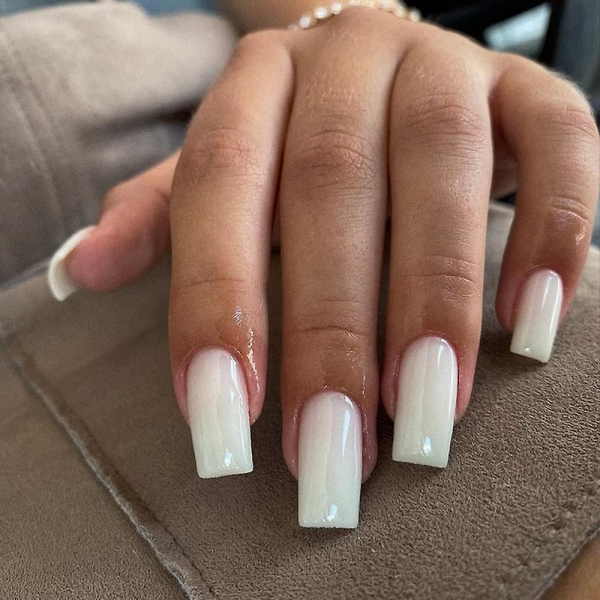Almond nails are often considered feminine due to their elegant and graceful appearance, which is reminiscent of the shape of an almond. Here are some reasons why almond nails are associated with femininity:
-
Soft and Curved: Almond nails feature soft, curved edges and a tapered tip that resembles the natural shape of the fingertip. This gentle curvature creates a soft and feminine look that complements the shape of the fingers.
-
Flattering: The elongated shape of almond nails can visually lengthen the fingers and create a slender and graceful appearance. This flattering effect is often associated with feminine beauty ideals and is considered elegant and sophisticated.
-
Versatile: Almond nails are versatile and can be customized to suit different styles and preferences. Whether worn short or long, with neutral polish or intricate nail art, almond nails have a timeless and feminine appeal that transcends trends.
-
Classic and Timeless: Almond nails have been a popular nail shape for generations and are often associated with classic and timeless beauty. This enduring popularity reflects the timeless elegance and femininity of almond nails.
-
Delicate and Refined: The slender and tapered tip of almond nails creates a delicate and refined look that is often associated with femininity. This dainty appearance adds a touch of sophistication and femininity to any nail design.
-
Attention to Detail: Achieving the perfect almond nail shape requires attention to detail and precision. The careful shaping and filing of the nails to create the almond shape exemplify the care and attention that is often associated with feminine grooming rituals.
-
Cultural Associations: In many cultures, long, slender fingers and well-groomed nails are considered symbols of femininity and beauty. Almond nails embody these ideals by enhancing the natural shape of the fingers and creating a graceful and feminine silhouette.
Overall, almond nails are considered feminine due to their soft, curved edges, flattering shape, and timeless elegance. Whether worn short or long, almond nails have a graceful and delicate appearance that is universally appealing and embodies feminine beauty ideals.

A French manicure is a classic and timeless nail design characterized by a natural or nude-colored base with white tips. Here's everything you need to know about French manicures:
-
History: The French manicure was popularized in the 1970s and became a staple in nail salons worldwide in the 1980s. It was originally created by Jeff Pink, the founder of the nail care brand ORLY, as a versatile and elegant nail look suitable for any occasion.
-
Classic Design: The classic French manicure features a sheer, pale pink or nude polish applied to the entire nail bed, followed by white polish carefully painted along the tips of the nails. The white tips create a clean and polished look reminiscent of natural, healthy nails.
-
Modern Variations: While the classic French manicure remains popular, there are many modern variations and interpretations of the design. Some variations include colored tips (such as black, red, or metallic), glitter or shimmer accents, or alternative base colors (such as pale blue or soft lavender).
-
DIY vs. Professional: French manicures can be done professionally at nail salons or achieved at home with a DIY kit. While professional manicures offer precision and expertise, DIY kits are convenient and cost-effective for achieving a French manicure at home.
-
Techniques: Achieving the perfect French manicure requires precision and attention to detail. The white tips are typically created using nail guides or striping tape to ensure clean lines. Alternatively, some nail technicians use a white polish brush or nail art brush to freehand the tips.
-
Maintenance: French manicures are known for their longevity and versatility. The neutral colors make regrowth less noticeable, allowing the manicure to last longer between touch-ups. However, regular maintenance is still necessary to keep the nails looking fresh and polished.
-
Suitability for All Occasions: One of the key advantages of the French manicure is its versatility. It's suitable for a wide range of occasions, from everyday wear to formal events such as weddings or parties. The understated elegance of the French manicure makes it a timeless choice that complements any outfit or style.
-
Nail Health: French manicures can help promote nail health by protecting and strengthening the nails. The application of polish can provide a protective barrier against environmental damage, while regular maintenance encourages healthy nail growth.
-
Customization: French manicures can be customized to suit individual preferences and style preferences. Whether you prefer a classic, understated look or want to add a modern twist with unique colors or accents, there are endless possibilities for customizing your French manicure.
-
Timeless Appeal: Despite evolving nail trends, the French manicure remains a timeless and iconic nail design beloved by many. Its simplicity, elegance, and versatility have ensured its enduring popularity for decades.
The frequency of visiting a nail salon depends on individual preferences, lifestyle, and nail care needs. Here are some factors to consider when determining how often to go to the nail salon:
-
Maintenance: If you prefer to keep your nails looking polished and well-groomed at all times, you may choose to visit the nail salon more frequently for regular manicures or pedicures. This could range from once a week to once every two weeks, depending on how quickly your nails grow and how well the polish holds up.
-
Special Occasions: Many people visit the nail salon before special occasions such as weddings, parties, or vacations to get a manicure or pedicure. If you have a special event coming up, you may schedule a salon appointment as needed.
-
Natural Nail Growth: The rate at which your nails grow can affect how often you need to visit the nail salon for maintenance. If your nails grow quickly, you may need more frequent manicures or pedicures to keep them looking neat and trimmed.
-
Gel or Acrylic Maintenance: If you get gel or acrylic nails, you may need to visit the nail salon every two to three weeks for fills or touch-ups to maintain the appearance and integrity of the artificial nails.
-
Budget: Consider your budget when deciding how often to visit the nail salon. Regular salon appointments can add up in cost, so it's important to balance your nail care needs with your financial situation.

-
At-Home Maintenance: Some people prefer to do their own nail care at home between salon visits. You can extend the life of your manicure or pedicure by using nail polish remover to clean up any chipped or faded polish and applying a fresh coat of polish as needed.
-
Nail Health: Consider the overall health of your nails when determining how often to visit the nail salon. If your nails are strong and healthy, you may not need to go to the salon as frequently. However, if you have specific nail concerns or conditions, such as fungal infections or brittle nails, you may benefit from more regular professional care and attention.
Ultimately, there is no one-size-fits-all answer to how often you should go to the nail salon. It's important to find a schedule that works for you and meets your individual nail care needs, whether that means visiting the salon regularly or only on occasion. Listen to your nails and prioritize their health and well-being when making decisions about nail salon visits.






